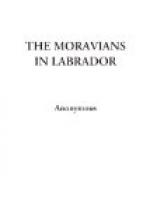meetings, where the gospel was preached to the resident
Esquimaux and numerous visitors. A school was
opened for children, besides which, the baptized were
twice a-week instructed in writing. A weekly
meeting was likewise kept with the latter for furthering
their knowledge on doctrinal points, particularly
on the meaning of the Lord’s supper. During
the season when the baptized were necessarily called
away from the settlement, one of the missionaries
generally attended them. In the year 1780, William
Turner made two visits of twenty miles each into the
interior of the country from Nain in their company
when they went to hunt the rein-deer, along with a
number of the Esquimaux; the first in February, and
then from the 8th of August to the 25th of September.
They travelled over wild mountains between lakes and
pools. The rein-deer, which sometimes passed
in large herds, were driven into the water by the
Esquimaux and there killed. In the winter journey,
Turner suffered much from the cold and the want of
warm food, and was also frequently in imminent danger
from the snow storms, when the great drift-heaps collected
upon the mountains rolled down in tremendous and threatening
masses like Alpine avalanches. Nor was the summer
expedition free from its dangers and difficulties.
The party consisted of fifty men, who travelled on
foot; about a hundred dogs followed, laden with the
baggage that was to be transported over barren mountains
and through morasses; and often, after all their exertions
and deprivations, they got very few rein-deer.
The main design of his journeys too, was but imperfectly
obtained, as his people were so very much occupied
in the hunt that they could pay but little attention
to the preaching of the word; and their heathen companions
disliked the presence of a missionary, as it caused
those to keep back who believed in their superstitious
customs and practices, and who practised them, and
on whom, according to their notions, the success of
the hunt depended.
From the promising appearances of the two settlements,
the brethren now began to think of a third, to be
situated south from Nain; and in July 1779, Schneider,
Lister and Jensen went to Arvertok, which Jans Haven,
Lister and Beck had formerly visited, and pitched upon
a spot deemed the most proper for a missionary station.
Having purchased the land from the Esquimaux, and
fixed the boundaries, placing stones as on the former
occasion; they then returned to Nain, where the wood
was prepared as for the missionary house at Okkak,
and brought to its destination by the Good Intent,
on her arrival from England. In the meantime,
Jans Haven, who had been on a visit to Europe, arrived
with his wife, after having experienced a wonderful
escape on their voyage. When approaching near
the coast of Labrador, they discovered an ice-berg
of prodigious extent and height approaching them, and
had scarcely passed it in safety ere it fell to pieces
with a tremendous crash, putting the surrounding sea
into the most dreadful agitation and foam. Had
it happened but a few minutes before, they must every
soul have perished in the immense ruin.—All
the preparations being finished, the building was
begun in 1782 at the new station, and Jans Haven was
employed as first architect. On the 21st September
of that year it was finished so as to be habitable.




